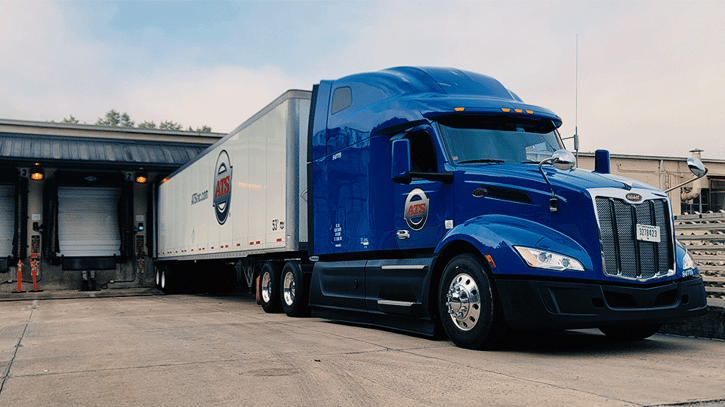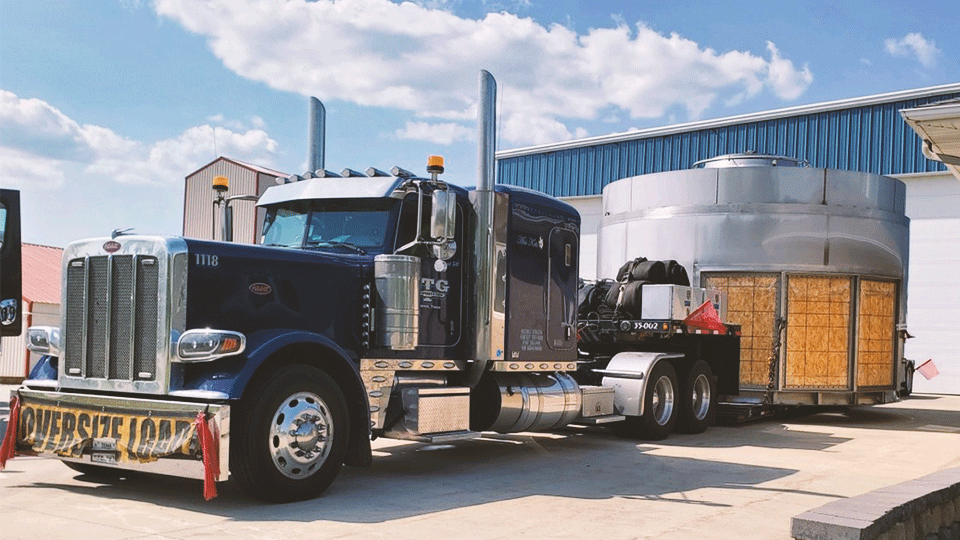July is a hot month in the trucking industry, and we're not talking about weather. (At least, not just weather - it gets freaking hot in these cabs, people!)
As Q3 kicks off in July, we see the southern states' produce season continues to ramp up, household goods move nationwide, and the Independence Day holiday put a dent in truck capacity.
Anderson Trucking Service, Inc. (ATS) has been around for a lot of Julys. As a result, we’ve refined our understanding of the trucking industry during this month and we’re here to explain what you should expect.
This busy summer month can be hard on the shippers who don’t plan for the intricacies of finding capacity.
In this article, we’ll tell you everything you need to know about locating trucking capacity in July including:
- How dry van and reefer capacities are impacted in July
- How open-deck capacity is impacted in July
- How Canada Day will impact truck capacity
- How the 4th of July will impact truck capacity
- How the DOT’s Operation Safe Driver Week will impact truck capacity
Hold on to your floppy-brimmed hats and break out your sunscreen, friends. Let's get into it!
How Are Dry Van and Reefer Capacities Impacted in July?
In most months, enclosed trailers like dry van and reefers offer companies reliably sourced capacity when and where they need it, even on short notice.
During July though, securing a dry van or reefer trailer for your freight may feel a little different and prove more elusive, due to two main factors:
Together, these factors will impact your ability to find dry van and reefer truck capacity over the next 31 days.
Produce Harvest in the Southern United States
Feeding the nation fresh produce is no small task. Doing so correctly requires coordination between many stakeholders to ensure that perishable items — like strawberries — line store shelves before their expiration.
To move these items quickly, the demand for reliable reefer and dry van capacity spikes in many southern states throughout July including, but not limited to:
| Georgia | Alabama | Florida | Texas | California |
|
|
|
|
|
Rising demand is great for the truck drivers in these areas - which makes finding capacity for your outbound freight more difficult. Drivers want to be efficient with their time, and produce season gives them the opportunity to optimize their schedules with a high volume of freight.
From one load to the next, drivers certainly aren’t hurting for work, which makes enticing them to leave these regions more expensive. As a result, expect to pay a bit more — as you did in June — to secure dry van or reefer capacities out of these regions during July.

On the flip side, finding a truck into these states should be a bit easier this July.
Truckers nationwide recognize the capacity uptick in these regions at this time of year. When a driver knows they’ll be able to find their next load at your endpoint, their willingness to move your freight into these locations increases.
If your freight brings drivers closer to the waves of fresh produce throughout these regions, you may get a break on your rate.
Household Goods Season Nationwide
July also ushers in the final four weeks of household goods season throughout our nation. With the kids out of school, July is the perfect month for American families to take the plunge and make their big move.
Household goods subsequently must move from one residence to the next - and now more than ever, people have a lot of stuff.
So much stuff, in fact, that many moving families will require the services of some truckers to get everything transported safely.
Often, these trailers are dropped for several days while loading/unloading occurs, further tightening capacity.
As such, demand for truck drivers pulling dry vans rises during July’s household goods season, making it more difficult (and more expensive) to find a truck.
How Is Open-Deck Capacity Impacted in July?
From northern states where the weather is toasty, to the predictably balmy south, everything opens up in July.
The frost laws and weight restrictions on northern highways are no longer in effect, opening these roadways for the heavy influx of oversize freight that’s sure to come.
In the north, farm and construction machinery transported on specialized flatbed trailers are in constant motion in the sticky July heat. Harvest season is coming in these regions and July is a great time to get the necessary pieces in place.
As a result, finding open deck capacity during July — especially across the upper Midwest — may cost a bit more than usual.

July in the southern parts of our nation also sees an influx of over-dimensional and open-deck freight.
As continued infrastructure improvements and food production ramp-up before Fall rears her anxiously awaiting head, expect to battle with other shippers for open-deck capacities this month, which will cost a bit extra.
What Else Should You Plan For This July?
July has a couple of holidays you should be aware of and plan for, as they could impact your ability to find a truck — especially on short notice.
These are:
How Will Canada Day Impact Truck Capacity?
Three days before the 4th of July stalls supply chains across the United States, Canada Day does the same for our neighbors up north.
Across the border, July 1 is a national holiday where Canadian citizens celebrate their nation's independence and unification. Canadian flags fly high in the sky as the nation's workers take the day off accordingly.
As such, if you're looking to get goods across the U.S.-Canada border in the day leading up to or following July 1st, expect to have more difficulty doing so. Be sure to plan ahead for any shipments to and from Canada during this period, as truck capacity — especially on the Canadian side — will come at a premium.

How Will The 4th of July Impact Truck Capacity?
Understandably, drivers don’t want to be on the road during the 4th of July holiday, especially when they could be enjoying some well-deserved time off.
The lack of on-duty truckers can make finding capacity in the days leading up to and following Independence Day more difficult — especially if the 4th falls on a weekday.
To combat this, you’ll want to lengthen your pick-up and delivery windows wherever possible. This will give drivers added flexibility with their scheduling and help you avoid the cost of finding a trucker who can meet a strict appointment on or around the holiday.
There are also many state-level restrictions on the transportation of over-dimensional cargo during this holiday period (usually from July 2 - 6) in the interest of keeping the roads safe for all members of the motoring public.
These restrictions vary from state to state, so if you're in the business of moving OD freight during this period, make sure to consult your provider on how travel restrictions over the 4th of July will impact your freight.
Learn More About State-By-State Permitted Travel Restrictions this Fourth of July
How Will DOT Operation Safe Driver Week Impact Truck Capacity?
Every July, the U.S. Department of Transportation, in conjunction with the Commercial Motor Vehicle Safety Administration, administers an “Operation Safe Driver Week” in the hopes of heavily monitoring and checking up on driver safety.
This year, the DOT and area police officers will have a heavy presence on America’s roadways July 7-13.
During this period, law enforcement will be out in full force checking drivers — both commercial and individual — for seatbelt usage and speed adherence. Additionally, commercial drivers will be checked for electronic logging device (ELD) accuracy if they are pulled over during this time.
Increased governmental ELD oversight will make drivers hyper-vigilant about properly adhering to hours of service regulations and maintaining their clocks.
As such, truckers will want to prevent being accidentally thrown off schedule due to slow loading times or inefficiencies on a shipper’s part.
As a shipper, you can set yourself up for success over Operation Safe Driver Week by focusing on three things:
- Give your provider proper lead time so that they can properly plan for your pick up. This will help them maintain the hours of service and stay on track.
- Be realistic about the time it takes to load trucks with outbound freight. Making sure that your loading times are optimized for efficiency will help truckers during this period.
- Be flexible with your schedule when possible. Tight appointments will be increasingly difficult for drivers to meet, especially if their HOS clock is adjusted because of delays. Being flexible with your pick/drop requirements will make your freight far more attractive to drivers this July.
How Should You Prepare For July In the Trucking Industry?
July is undoubtedly an incredibly busy time in the trucking industry. But no matter how busy you get, you still can't lose sight of your budget and timeline requirements.
What action can you take to get the most out of both? Well, the number one recommendation we have is to give your transportation provider an adequate amount of lead time.
A good rule of thumb for advanced notice is between 48-72 hours before the time your shipment needs to load, though this can vary by equipment type, commodity, region, etc.
Given a decent amount of lead time, your transportation partner should be able to secure your truck at a reasonable price and get it to your facility on time.
Another great way to make sure that you make the most of your budget this June is to ask your provider questions about each of the factors we’ve outlined above, like:
- How will the harvest in the south-southeast impact my shipment?
- How should I plan for my shipment over the 4th of July?
- Will the movement of household goods nationwide impact my freight?
- How can I maximize my budget this July?
Asking questions like these will help you find the right provider for your needs and, in turn, make the most of your shipping dollars this month.
Finally, allowing some wiggle room in your pick-up and/or drop-off windows will make it far easier to find a truck. The more flexibility you can give drivers, the more likely you’ll be to find a freight solution.
So, in short: Yes, July is a busy month — but it doesn’t have to be chaotic.
If you'd like to find out more about how ATS can help you get your freight moved efficiently and cost-effectively this July, feel free to reach out to the ATS team.
We're always happy to help shippers like you find the answers to their questions and make the best decision possible for their business.
